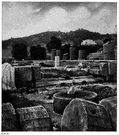|
|

The Statue of Zeus at Olympia
The Statue of Zeus at Olympia was one of the Seven Wonders of the Ancient World. It truly was a wonder to behold. The building itself, designed in 450 b.C. by the architect Libon, was as tall as a modern four-story building, and the statue filled most of it. Zeus's head nearly brushed the ceiling, he was so tall. The noted geographer Strabo once commented that if Zeus were to come to life and stand up, "he would unroof the temple."
 The statue was made of ivory, a gleaming symbol of the Greeks' reverence for the head of the gods. Zeus wore a robe and jewels made of gold; also made of gold were the sandals he wore. The throne on which Zeus sat was made of cedarwood and was inlaid with ebony, ivory, gold, and jewels. Zeus held in his left hand a shining scepter, on top of which an eagle perched, ready to take off at any moment and do the god's bidding. In Zeus's left hand rested a statue of goddess of victory Nike. The statue was made of ivory, a gleaming symbol of the Greeks' reverence for the head of the gods. Zeus wore a robe and jewels made of gold; also made of gold were the sandals he wore. The throne on which Zeus sat was made of cedarwood and was inlaid with ebony, ivory, gold, and jewels. Zeus held in his left hand a shining scepter, on top of which an eagle perched, ready to take off at any moment and do the god's bidding. In Zeus's left hand rested a statue of goddess of victory Nike.
The monument was carved by Phidias, considered the greatest Greek sculptor. Phidias it was who also designed the overpowering statue of Athena that stood in the Parthenon and other, smaller, statues at such landmarks as Marathon and Plataea.
The statue of Zeus at Olympia was completed by 435 B.C. It lasted as an inspiration to and destination for thousands for many years. It resisted many attempts to usurp its authority in the eyes of its visitors. The Roman Emperor Caligula, jealous of its power over his newly conquered "citizens," ordered it moved to Rome. The scaffolding attached to the statue collapsed, accompanied by, according to legend, a loud laughing noise. The temple and statue survived earthquakes and other natural disasters until it was uprooted and carted off to Constantinople, in A.D. 394. It was lost in an accidental fire in 462.
 A few columns of this famous landmark have been uncovered during 19th and 20th Century archaeological digs, but that is all that remains of the once magnificent statue. A few columns of this famous landmark have been uncovered during 19th and 20th Century archaeological digs, but that is all that remains of the once magnificent statue.
|
|